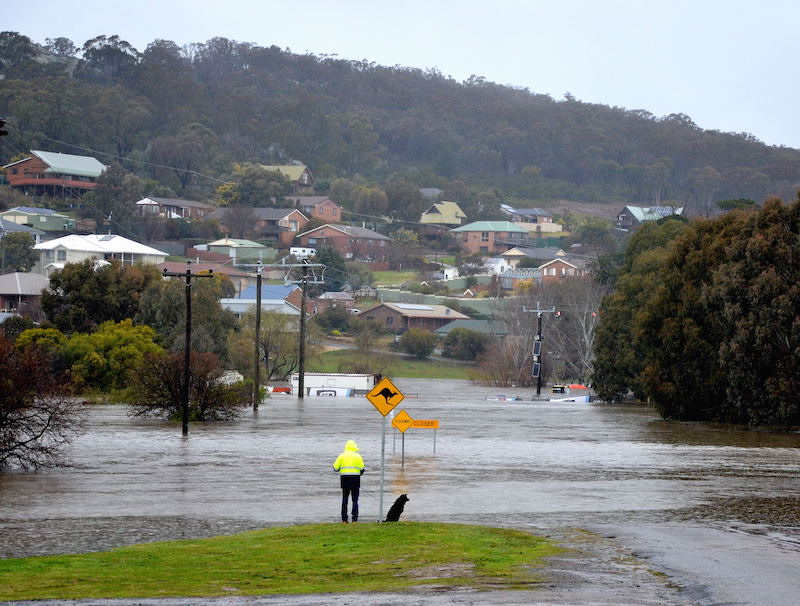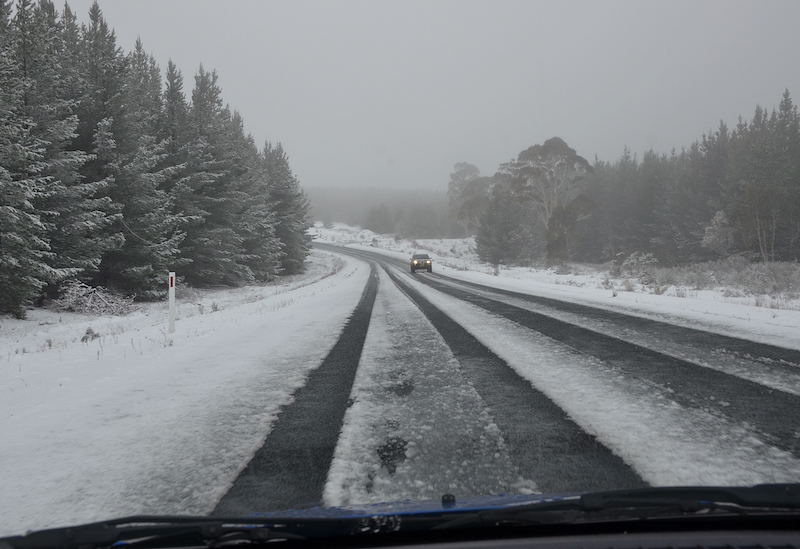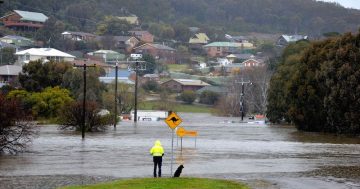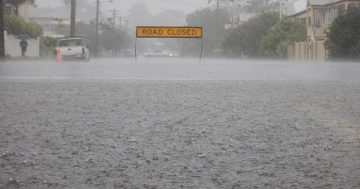
Lower Sterne Street on 9 August, 2020. More than 83mm of rain fell on this day. Photo: Leon Oberg.
Goulburn’s weather ended the past decade the way it began: with drought-breaking rain. The sodden years of 2010 and 2020 were sandwiched between fierce, record-breaking extremes.
In 2020, 825mm was recorded at Goulburn TAFE’s weather station, swamping the 684mm annual average. During August, 170mm fell, including 83.4mm in one day on 9 August. In 2010, 915.4mm fell, ending years of below-average rainfall and prolonged drought.
Weather watchers say southeast Australia, including Goulburn, can expect warmer temperatures, more droughts and more short, intense rainfall in the future.
The city sizzled on 11 February, 2017, when 41.2 degrees was recorded at Goulburn TAFE’s weather station. The mercury soared again on 4 January, 2020, with 42.8 degrees recorded at Goulburn Airport.
On 2 July, 2017, the temperature plummeted to -10.4 degrees (the record low on 17 August, 1994, was -10.9 degrees).
Two people in separate fields, who spend much time out in the weather, have learned to work with it and to expect the unexpected. Along their journeys, in different parts of the city and the Southern Tablelands, Ray Shiel and Alana Boxsell’s appreciation of Mother Nature has risen with every season.
During the decade, Ray, a retired farmer and one of the founders of Goulburn Wetlands, has watched them fill, empty, fill again and flourish as nature intended. On that bone-chillingly cold day in July 2017, Ray says an icy wind followed the old river billabong along the Mulwaree chain of pounds valley, driving the temperature even lower to -25 to -30 degrees.
“The chill wiped out all the Acacia melanoxylon [blackwood],” he says. When sustained rain fell throughout 2020, fresh acacia shoots began their next cycle.

Snow and ice along Oberon Road in winter. Photo: Leon Oberg.
Beady-eyed long-necked turtles that proliferated after rain disappeared as drought evaporated their underwater habitat. Many buried themselves deep in the mud as the ground’s surface became cracked and seared. Now the turtles are back in numbers, having either resurfaced or perhaps travelled long distances to reach the recharged wetlands.
Hundreds of different water birds are returning, and frogs are also back, providing a smorgasbord for the tiger snakes and eastern brown snakes that hide in rock piles left for their benefit.
Away from the wetlands, Alana Boxsell has created and nurtured homestead gardens for almost 30 years. She is hands-on every day, working with positive and negative outcomes of the district’s weather extremes, and learning by solving problems.
“Snow is like a slow-release fertiliser – it is full of nitrogen and so is hail,” she says. “Snow can also protect an environment. If you are in an area, say the lower Snowy Mountains, and you have light powdery snow, it can actually form a barrier and protect plants from frost with that light covering.”
Alana says bulbs love the cold weather and thrive across the Southern Tablelands. They need the cold temperatures, as do European deciduous trees.
“Natives are a fast grower,” she says. “A lot of rain fell last year – a native windrow of eucalypts, 10-15 years old, really suffered during the drought, but then we had a lot of rainfall and within six to eight weeks you could notice the new growth. They had six, maybe 10 inches, of new growth.”

Flood waters fill Goulburn Wetlands in August 2020. Photo: Leon Oberg.
In many of Alana’s gardens, due to the dry winter, tulips that were left in the ground flowered splendidly in one of their best displays.
“They did not have that moisture in the ground, whereas in previous years if we had a wet winter they don’t flower as well,” she says. “Tulips are meant to be lifted every year so they don’t rot in the soil.
“We have had a wonderful season through late winter-early spring. We have had lovely rain and it is unseasonal, but that can also have detrimental effects. This season, we have a lot of blackspot and fungal diseases, whereas 2019 was very dry – you just don’t have that disease.
“This season, we will have a lot of bugs and other things in the garden because of moisture.”
Guided by the weather, each season changes the way Alana works.
“I just mentioned the lovely wet weather we have had,” she says. “I will have to do a lot of preventative care in gardens this year.”
The Bureau of Meteorology and CSIRO’s latest State of the Climate report says Australia’s warmest year on record was 2019. A long-term warming trend means that most years are now warmer than almost any observed during the 20th century.
Original Article published by John Thistleton on The RiotACT.











